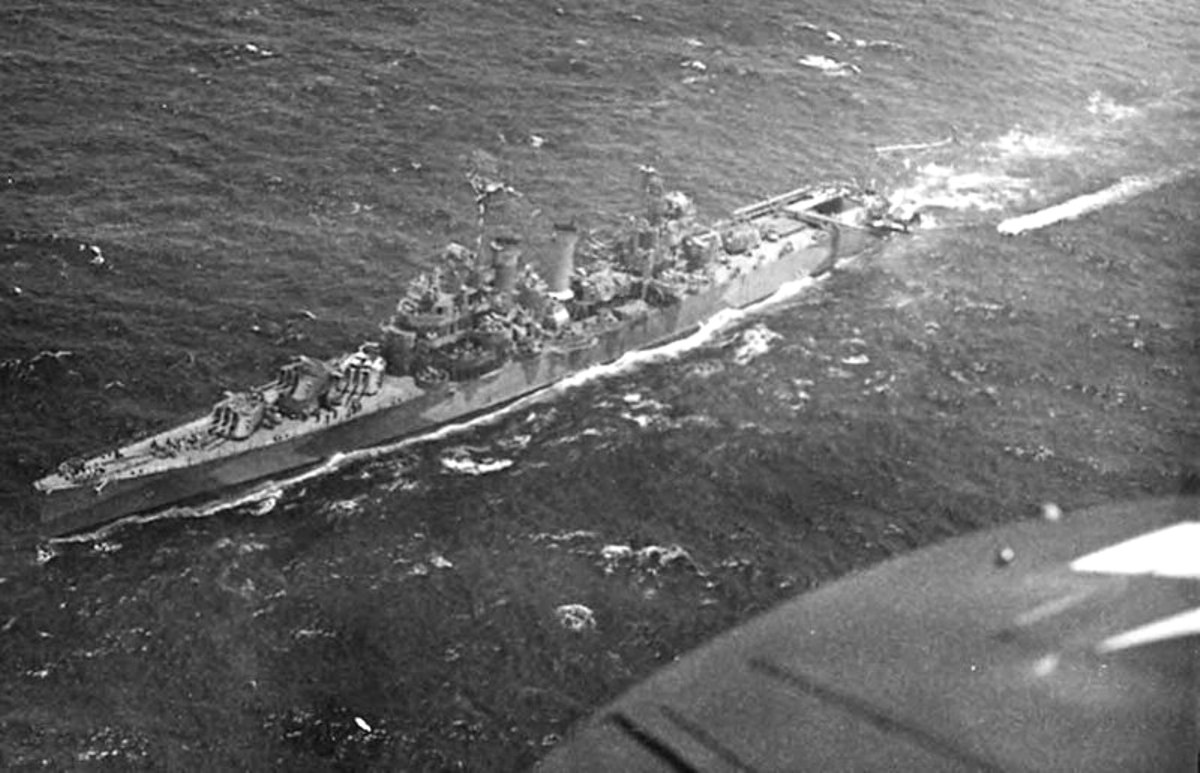
| Historical Information | |||||
| Caption | Aerial view of the cruiser USS Nashville underway, Pacific 1944 ww2dbase | ||||
| Date | 9 00 1944 | ||||
| Photographer | Unknown | ||||
| Source Information | |||||
| Source | ww2dbaseUnited States Navy | ||||
| Related Content | |||||
| More on... |
| ||||
| Colorized By WW2DB |
Colorized with Adobe Photoshop |
||||
| Licensing Information | |||||
| Licensing | Public Domain. According to the United States copyright law (United States Code, Title 17, Chapter 1, Section 105), in part, "[c]opyright protection under this title is not available for any work of the United States Government". Please contact us regarding any inaccuracies with the above information. Thank you. |
||||
| Metadata | |||||
| Added By | David Stubblebine | ||||
| Photo Size | 1,200 x 773 pixels | ||||
Please consider supporting us on Patreon. Even $1 per month will go a long way! Thank you. Please help us spread the word: Stay updated with WW2DB: |
Visitor Submitted Comments
2.  David Stubblebine says:
David Stubblebine says:
26 Jun 2021 01:12:05 PM
Craig R (above):
I think you are absolutely correct right down the line. I think the port catapult is swung out because it is streaming the tow line for the recovery mat. The opening in the deck to the aircraft hangar became significant later when the aviation unit was assigned the Curtiss SC Seahawk as a replacement for the Vought OS2U Kingfisher (seen here). The Seahawk was a larger airplane with folding wings that created an awkward shape and had problems fitting through the hangar opening, particularly while underway. Nashville war diaries from that period devote significant space to complaining about how ill-suited the Seahawk was as compared to the Kingfisher.
26 Jun 2021 01:12:05 PM
Craig R (above):
I think you are absolutely correct right down the line. I think the port catapult is swung out because it is streaming the tow line for the recovery mat. The opening in the deck to the aircraft hangar became significant later when the aviation unit was assigned the Curtiss SC Seahawk as a replacement for the Vought OS2U Kingfisher (seen here). The Seahawk was a larger airplane with folding wings that created an awkward shape and had problems fitting through the hangar opening, particularly while underway. Nashville war diaries from that period devote significant space to complaining about how ill-suited the Seahawk was as compared to the Kingfisher.
All visitor submitted comments are opinions of those making the submissions and do not reflect views of WW2DB.
Search WW2DB

News
- » US State Lawmaker John Winter Caught Using Racial Slur "Jap" and Apologized (11 Jun 2025)
- » Köln/Cologne Evacuated After Discovery of WW2 Bombs (4 Jun 2025)
- » US Women's Army Corps "Six Triple Eight" Awarded with Congressional Gold Medal (30 Apr 2025)
- » Race, Holocaust, and African-American WW2 Histories Removed from the US Naval Academy Library (7 Apr 2025)
- » US Government Plans to Purge WW2 Information (17 Mar 2025)
- » See all news
Current Site Statistics
- » 1,175 biographies
- » 337 events
- » 44,927 timeline entries
- » 1,245 ships
- » 350 aircraft models
- » 207 vehicle models
- » 376 weapon models
- » 123 historical documents
- » 261 facilities
- » 470 book reviews
- » 28,466 photos
- » 365 maps
Famous WW2 Quote
"An appeaser is one who feeds a crocodile, hoping it will eat him last."Winston Churchill
Support Us
Please consider supporting us on Patreon. Even $1 a month will go a long way. Thank you!
Or, please support us by purchasing some WW2DB merchandise at TeeSpring, Thank you!
25 Jun 2021 12:02:40 PM
This is an interesting photo, and appears to show the Nashville during floatplane recovery.
Note the 'extra' wake just off her port quarter, indicating that she's dragging a recovery net to help retrieve a floatplane after it lands; it's possible that this photo was taken from that very plane, though I have no way of knowing for certain.
Also of interest is another floatplane mounted on Nashville's port catapult, which is swung out; the plane is perched over the water. Between Nashville's catapults (just forward of the aircraft handling crane, which is also swung outward over the water) is a large, rectangular open area at the stern. This is the hangar area for the ship's floatplanes.